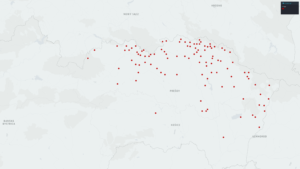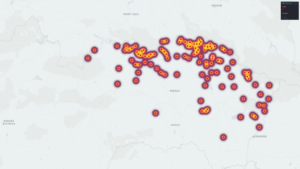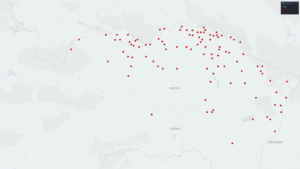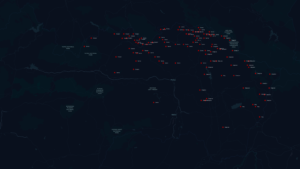For my project, I wanted to find out more information about the villages where the Carpatho-Rusyn people have historically lived in Europe. The Carpatho-Rusyns are an East Slavic ethnic group that have lived for centuries in and around the Carpathian Mountains in what is today Poland, Slovakia, and Ukraine. There are estimated to be around six hundred villages that make up the core of historic Carpatho-Rusyn settlement which means that fifty percent or more of the population identified as Carpatho-Rusyn.
This project came about as a result of my personal family research which I have conducted over the past year. I discovered that my paternal grandfather’s ancestors were Carpatho-Rusyns from what is today Slovakia, who immigrated to the United States. My desire to learn more about my own family led me to want to research the villages my ancestors were from. My goal was to find out what kind of relationships I could find between the different villages looking at a variety of different facts about the villages, and create a project that could be shared with other people who have Carpatho-Rusyn ancestry interested in learning about where their ancestors were from.
I decided that the best way to compare the different villages was through creating a data sheet in Microsoft Excel and uploading it to the mapping software Kepler.gl. I choose Kepler.gl because it allows for the creation of a variety of different map types that can analyze relationships contained in the different categories that my data set contained, and using mapping software made sense since my data concerned villages with fixed geographic points.
One of the first decisions I made was to narrow my focus to only one hundred and six villages found in the Prešov region of northeast Slovakia. I choose to focus on these villages as it was a much more manageable amount of data to work with rather than looking at all of the six hundred Carptho-Rusyn villages in Poland, Slovakia, and Ukraine. I specifically choose this region of Slovakia because that is where my ancestors are from and I have a personal connection to three of the villages there.
Once I decided which villages I wanted to include, I next created categories for my data sheet about each of the different villages. The categories that I decided to include were the name of the village in Rusyn, the name of the village in Slovak, the name of the village in Hungarian, the year that the village was either established or was first mentioned in written sources, the historical county in the Kingdom of Hungary where the village was located, the current district of Slovakia where the village is located, and the latitude and longitude of the village. I obtained all of the information about the different villages from the Carpatho-Rusyn Knowledge Base and The Carpathian Connection (both of which I have provided links to at the end of the post).
Once all of the data was compiled into the spread sheet, I uploaded it to Kepler.gl and created five different maps with the software to analyze different relationships contained in the data. From these five maps I was able to learn a few different things about the one hundred and six Carpatho-Rusyn villages that I examined. First, I discovered that the villages were scattered across the entire Prešov region of Slovakia, and a few of the villages were found in the northern Košice region. Second, I found that the highest density of villages could actually be found in the northern Prešov region close to the Slovak-Polish boarder. Next, the time map I created revealed that the period between 1397 and 1422 saw the largest amount of villages either being established or first mentioned in written sources. Finally, I discovered that the largest amount of villages were located in the historic Hungarian counties of Saros and Zemplen and the current Slovak districts of Stará Ľubovňa, Svidník, and Bardejov.
This project is one that I would like to expand upon in the future. I see this project as a starting point for learning more about the Carpatho-Rusyn villages in Europe. I would like to eventually expand my data sheet to include all of the Carpatho-Rusyn villages in Poland, Slovakia, and Ukraine. With this expanded data set I will create new maps to be able to analyze the relationship between all of the over six hundred villages.
Carpatho-Rusyn villages point map

Carpatho-Rusyn villages heat map

Carpatho-Rusyn villages time map

Carpatho-Rusyn villages in Historic Hungarian Counties

Carpatho-Rusyn villages in Current Slovak Districts

Carpatho-Rusyn Villages in Slovakia: Data Set
Links for village data:
http://www.carpatho-rusyn.org/villages.htm
https://www.tccweb.org/carpathorusynvillages.htm

Andrew-
I’ve found your project most interesting. I visited my mother’s family’s ancestral village in time for their annual festival in 2018. The village is Jarabina (aka Jarembina or Orjabina), located an hour’s walk north of Stara Lubovna. I am probably related to half the people in the village from what I can see from my work on Ancestry.com. My sister and I actually had to stay over the border in Piwniczna Poland since we made our reservations late. Do you know whether the Piwniczna residents are Rusyn. I didn’t have much luck communicating with them. The folks in Jarabina seemed to speak several languages, Slovak, Czech, English, Russian (though they avoided that), and some of the old folks still spoke Rusyn. Thanks for working on this.
John,
I am really glad to hear that you found enjoyed my project and found it to be interesting. As I said this project was just the beginning of mapping all of the Rusyn villages in Europe, something that I would eventually like to be able to complete. That’s amazing that you and your sister were able to go and visit your ancestral village. Eventually I would like to take my dad to see the village where his grandfather and my great-grandfather came from Osadne. To answer your question I did not find Piwniczna listed as a Rusyn village on the map of Rusyn villages I have that I bought from the Carpatho-Rusyn Research Center.
I visited my relatives in Slovakia (Czechoslovakia at that time) in 1976, and remember Presov and Kocice as the bigger towns the train went through. Is the village of Kamenica one of the Rusyn villages? That’s where my relatives are from.
Judi, according to the map I have from the Carpatho-Rusyn Research Center, yes Kamenica is a historic Rusyn village, meaning at one time the majority of the population were ethnic Rusyns.
Andrew, this is an amazing project. Come join the reddit.com/r/rusyn discord.
Just wanted to let you know that Nizná Jablonká should be on your list. It’s my family’s home village and has been there since at least the 1430s and we are very much Carpatho-Rusyn.
I am researching my grandparents. One is from Nolepkovo(previously Vandrisel) the other a few miles north in Zavadka. Are these villages Rusyn?
Hi! This project is very interesting. My grandfather’s relatives are from Presov and Kocice. Our family surname is Kocis! But I am looking for my matrilineal great grandmother, whose name was Zupa, and is from a town Lelgov? Saros. She couldn’t write English of course so this is the best I could make out on her marriage license.